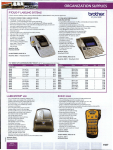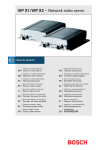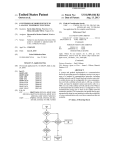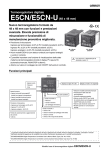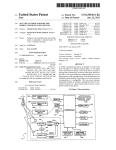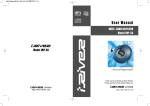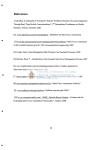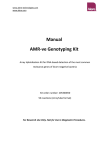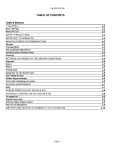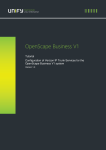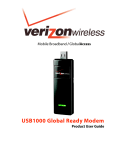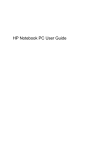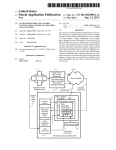Download Methods and systems for facilitating transfer of sessions between
Transcript
US 20130117457A1
(19) United States
(12) Patent Application Publication (10) Pub. No.: US 2013/0117457 A1
Allen et al.
(54)
(43) Pub. Date:
METHODS AND SYSTEMS FOR
FACILITATING TRANSFER OF SESSIONS
BETWEEN USER DEVICES
May 9, 2013
Publication Classi?cation
(51)
Int- Cl
H04L 29/08
(2006.01)
(52) US, Cl,
CPC
H04L 29/08639 (2013.01); H04L 29/08603
(71) Applicant: RESEARCH IN MOTION LIMITED,
Waterloo (CA)
2013.01
(72) Inventors? Andrew Allen, Mundelein, IL (Us);
USPC ........................................................ 7 09/227)
Youngae Kim, Mississauga (CA)
(57)
ABSTRACT
(73) Asslgnee' 3712251108011(CCg)IN MOTION LIMITED’
Methods and systems for facilitating transfer of an active
(21)
AP p1~ NO‘: 13/728,540
(22)
Filed
the same user. A network server is con?gured to enable the
switching or swapping of an active session from one device to
another device, where both devices are associated with a
session from a ?rst device to a second device associated with
'
Dec‘ 27 2012
’
common user address. The switching or swapping is imple
.
.
mented with no or minimal effect on the active session or
Related U's'Apphcatlon Data
(63)
awareness of the remote party. The device switch may be
Continuation of application No. 12/034,227, ?led on
performed in relation to any active session, including VolP,
Feb. 20, 2008, now Pat. No. 8,392,580.
video conferencing, or other media sessions.
14
I
_
16
"
30
v lnterworking
a
Media Storage 34
52
elements
Control Server
1
User Data Entity ii?
. Qt
v:
36
Generation
' Nxt
60
Network
Enterprise
Network
"
Remote
w
1 Communication
System
g0
'
.
2m
83
Patent Application Publication
May 9, 2013 Sheet 1 0f 6
US 2013/0117457 A1
mm
“gmm2i3wam
mutgaémiswu
1
A“
WmE@Em?m:
, sax‘ ,
gmw? NE?“
WM&@i,.WEQEQ
mm.
f
mm
{wig
aw.
l
g i
a.a
mum
&“Eg
w;
mum.wEwE?w .
mm
Patent Application Publication
3mu gmw
3wumrmw
May 9, 2013 Sheet 2 0f 6
US 2013/0117457 A1
Patent Application Publication
May 9, 2013 Sheet 3 0f 6
mimim
m
4%
mm
1
.
W
3wEmua5gxmrswa
WE.
Wi
m
@
M
m
m
W
mwcmnaw?vtmé
w
“gm
(Rax/m3g
mmw
m
US 2013/0117457 A1
Patent Application Publication
May 9, 2013 Sheet 4 0f 6
US 2013/0117457 A1
Patent Application Publication
May 9, 2013 Sheet 6 0f 6
E
m
W
Q»5w.H. m
m
.w
S mm
f
Mm
Jrmm
Rm n
“9T.
:Q$1gM“Q5
Si.
8m
m
a
n
m
US 2013/0117457 A1
May 9, 2013
US 2013/0117457 A1
METHODS AND SYSTEMS FOR
FACILITATING TRANSFER OF SESSIONS
BETWEEN USER DEVICES
CROSS-REFERENCE TO RELATED
APPLICATIONS
[0001] This application is a continuation application of
US. patent application Ser. No. 12/034,227, ?led Feb. 20,
2008, the contents of Which are hereby incorporated by ref
session. One mechanism is to terminate the previous session
and re-establish a neW session over the neW device, but that
Would be highly disruptive.
BRIEF DESCRIPTION OF THE DRAWINGS
[0007] FIG. 1 diagrammatically illustrates an example
communications system.
[0008] FIG. 2A shoWs an example How diagram for execut
ing a device sWitch during an active session.
[0009]
erence.
RESERVATION OF COPYRIGHT
FIG. 2B shoWs another example How diagram for
executing a device sWitch during an active session.
[0010] FIG. 3 shoWs an example interface for a device
con?gured to enable device sWitching.
[0002] A portion of the disclosure of this patent document
contains material Which is subject to copyright protection.
The copyright oWner has no objection to the facsimile repro
duction by any one of the patent document or patent disclo
sure, as it appears in the Patent and Trademark Of?ce patent
?le or records, but otherWise reserves all copyrights Whatso
[0011]
FIG. 4 is a block diagram of an exemplary mobile
device constructed in accordance With an embodiment dis
closed herein.
[0012] FIG. 5 is a block diagram of an exemplary commu
nication subsystem component of the mobile device in accor
dance With an embodiment disclosed herein.
ever.
DETAILED DESCRIPTION OF THE INVENTION
FIELD OF THE APPLICATION
[0003]
The present application relates, in general, to media
sessions and, in particular, to methods and systems for trans
ferring an existing active session from a ?rst device to a
second device associated With the same end user.
[0013] Example embodiments and applications Will noW be
described. It should be appreciated that other embodiments
may be realiZed and structural or logical changes may be
made.
[0014]
Embodiments disclosed herein relate to a telecom
munication messaging system that can selectively perform
BACKGROUND
[0004] It has become relatively common for individuals to
possess a number of different devices through Which they
messaging functions or session-based functions With one or
more of a plurality of IP-based messaging devices associated
With a particular user. Each of the plurality of IP-based mes
saging devices has a unique address. The plurality of IP-based
communicate. For example, a person may have a home tele
messaging devices may also have a common address. In order
phone, a Wireless telephone, a pager, a personal digital assis
Words, a user may have one address or number Which is
tant (PDA), and an of?ce telephone to name a feW. As the
population becomes increasingly mobile, making contact
associated With all the user’s devices, and each device may
have a unique address Which identi?es the speci?c device.
With a person through one of these communication devices
has become more dif?cult.
Addressing of the devices may include one or more address
[0005]
number), GRUU (Globally Routable User Agent URI), or
In the context of telephony, cell forWarding is one
types, such as SIP URI, SIPS URI, TEL URI (telephone
method of addressing this problem. Certain telephone sys
private numbering plan (PNP) (e.g., extension dialing)
tems alloW users to enter another number to Which a call is
addressing, etc.
[0015] A ?rst example embodiment is discussed and illus
forWarded if not ansWered by a speci?ed number of rings.
This should alloW an individual With multiple telephone
devices to forWard the call to such devices until the telephone
at Which the individual is located ?nally rings. HoWever, if
several telephones are involved, this approach becomes com
plicated. Moreover, it requires the calling party to remain on
the line for a signi?cant period of time if the call is to be
forWarded multiple times. Furthermore, it is necessary that
call forWarding capabilities exist on each of the individual’s
telephones. In addition, this approach requires that all tele
phones involved be reprogrammed each time an individual
desires to initiate call forWarding.
[0006]
At times, a user engaged in an active media session
With a remote party may Wish to move the session to one of his
or her other devices. For example, if the user is participating
in a Voice-over-IP (VoIP) session With a remote party using a
mobile device, he or she may Wish to move the session to an
of?ce or home telephone to preserve battery poWer in the
mobile device. In another example, if the user is engaged in a
multi-media session With a remote party, such as a video
conference, he or she may Wish to move the session from a
trated With reference to its implementation Within an SIP
capable IP netWork. In such an environment, a user may be
associated With multiple devices. For example, the user may
have a dual-mode mobile device, a desktop of?ce telephone,
a home personal computer, a WLAN-enabled o?ice laptop
computer, or other such devices. Each device may be con?g
ured for IP-based communication, Whether for messaging,
session-based communications, or both. In the ?rst example
embodiment, the SIP-capable IP netWork is con?gured to
enable converged seamless messaging and session function
ality and interoperability over multiple devices.
[0016] In embodiments described beloW, a server is con?g
ured to enable the sWitching or sWapping of, or is otherWise
requested to sWitch or sWap, an active session from one device
to another device, Where both devices are associated With a
common user address and each device has its oWn address
Which identi?es the speci?c device. A server has a mapping
table or other stored association that contains the association
betWeen the common user address and the user’s device
addresses. The sWitching or sWapping is implemented With
?xed device, like a desktop personal computer, to a mobile
no or minimal effect on the active session or aWareness of the
device so as to enable the user to move While maintaining the
remote party. The device sWitch may be performed in relation
May 9, 2013
US 2013/0117457 A1
to any active communication session, including VoIP, video
conferencing, messaging session, Push-to-Talk over cellular
(PoC) session, etc ., and is generally initiated by the user of the
devices.
[0017]
In some embodiments, session history information
is stored in the server and, When a device is swapped, the
session history information can be sent to and displayed on
the neW device upon a user’s request. Subject to user prefer
ences or service provider policies, all or a portion of the
session history information may be transferred to the neW
device and, in some embodiments, displayed on the neW
device.
[0018] In one aspect, the present application discloses a
method of facilitating transfer of an existing session from a
?rst user device to a second user device, Wherein the existing
session is established betWeen the ?rst user device and a
and a remote party and Wherein the existing session includes
a ?rst leg betWeen the ?rst user device and a server and a
second leg betWeen the server and the remote party. The
server stores an association betWeen a user address and both
the ?rst user device and the second user device. The method
includes receiving, at the server, a device sWitch message
from the second user device; determining from the stored
association that the second user device is associated With the
user address; identifying the existing session based on the
association betWeen the ?rst user device and the user address;
establishing a neW session With the second user device; join
ing the neW session With the second leg of the existing session
to enable the exchange of media betWeen the second user
device and the remote party; and terminating the ?rst leg of
the existing session.
[0021] In yet a further aspect, the present application dis
remote party and Wherein the existing session includes a ?rst
closes a server for facilitating transfer of an existing session
leg betWeen the ?rst user device and a server and a second leg
from a ?rst user device to a second user device, Wherein the
betWeen the server and the remote party. The server stores an
association betWeen a user address and both the ?rst user
existing session is established betWeen the ?rst user device
and a remote party and Wherein the existing session includes
device and the second user device. The method includes
receiving, at the second user device, a device sWitch message
from the ?rst user device, Wherein the device sWitch message
a ?rst leg betWeen the ?rst user device and the server and a
second leg betWeen the server and the remote party. The
from the second user device to the server a session invitation
server includes an IP communications interface for sending
and receiving IP-based communications over a netWork; a
user data entity containing user information including an
message containing a reference to the existing session With an
association betWeen a user address and both the ?rst user
instruction to replace the ?rst user device; verifying from the
device and the second user device; and a control subsystem
includes information identifying the existing session; sending
stored association that the second user device is associated
for controlling sessions. The control subsystem including a
With the user address; accepting the session invitation mes
device sWap component con?gured to receive from the sec
sage from the second user device to establish a neW session;
ond user device a device sWitch message, determine from the
stored association that the second user device is associated
joining the neW session With the second leg of the existing
session to enable the exchange of media betWeen the second
user device and the remote party; and terminating the ?rst leg
of the existing session.
[0019] In another aspect, the present application discloses a
server for facilitating transfer of an existing session from a
?rst user device to a second user device, Wherein the existing
session is established betWeen the ?rst user device and a
remote party and Wherein the existing session includes a ?rst
leg betWeen the ?rst user device and the server and a second
leg betWeen the server and the remote party. The ?rst user
device is con?gured to send a device sWitch message to the
second user device. The device sWitch message includes
With the user address, identify the existing session based upon
the association betWeen the ?rst user device and the user
address, establish a neW session With the second user device,
join the neW session With the second leg of the existing ses
sion to enable the exchange of media betWeen the second user
device and the remote party, and terminate the ?rst leg of the
existing session.
[0022]
The embodiments disclosed herein are not to be
limited to any particular environment.
[0023] Reference is ?rst made to FIG. 1, Which diagram
matically shoWs a communication system 10. As Will be
discussed beloW, the system 10 provides for a full integration
information identifying the existing session. The server
includes an IP communications interface for sending and
communication devices 70 (shoWn individually as 7011, . . . ,
receiving IP-based communications over a netWork, a user
70]). In this example, the communication devices 70 include
data entity containing user information including an associa
any device capable of IP-based communications. In one
embodiment, the device 7011 may be a mobile device con?g
tion betWeen a user address and both the ?rst user device and
the second user device, and a control subsystem for control
ling sessions. The control subsystem includes a device sWap
component con?gured to receive from the second user device
a session invitation message containing a reference to the
existing session With an instruction to replace the ?rst user
device, verify from the stored association that the second user
device is associated With the user address, accept the session
invitation message from the second user device to establish a
neW session, join the neW session With the second leg of the
existing session to enable the exchange of media betWeen the
second user device and the remote party, and terminate the
?rst leg of the existing session.
[0020] In yet another aspect, the present application dis
closes a method of facilitating transfer of an existing session
from a ?rst user device to a second user device, Wherein the
existing session is established betWeen the ?rst user device
of local and remote IP-based communication devices, such as
ured to connect With a Wireless local area netWork (WLAN)
40 through an access point using, for example, any one of the
IEEE 802.11 suite of communications protocols. In another
embodiment, the device 70b may be a personal computer or
computing device including a Ethernet card con?gured to
connect to an Wide area netWork (WAN) 45, for example via
an intemet service provider (ISP). In another embodiment,
the device 700 may be a Wireless mobile device con?gured to
connect With a Wireless Wide area netWork (WWAN) 60 using
any one or more of a number of radio protocols, such as
GSM/GPRS/EDGE, UMTS, CDMA, WiMAX, etc. In yet
other embodiments, an enterprise netWork 80 may include
devices such as a digital desktop telephone set 70d and/or a
personal Workstation 70e. Device 70f may be an IP-enabled
home phone, for example, or another device con?gured to
operated Within a Next Generation Network (NGN) 86, such
May 9, 2013
US 2013/0117457 A1
as TISPAN NGN or HFC cable networks. Other communi
cations devices 70 capable of IP-based messaging or session
based communications Will be understood by those skilled in
the art. It Will be appreciated that combinations of these
various embodiments (e. g., a home telephone, With business
telephone and Wireless mobile devices linked via IP to the
[0029] The system 10 includes a communication server 30.
The communication server 30 is connected to the IP netWork
50 and provides converged seamless messaging and session
functionality and interoperability over multiple devices. In
same core network) are also possible.
particular, the communication server 30 includes a control
server 32. The control server 32 provides the central logic and
control for the communications server 30 and enforces both
[0024]
user preferences and service provider policies. The control
Some of the devices 70 may be con?gured for mes
saging applications. Messaging applications may include
text-based messaging, including SMS, E-mail, Instant Mes
saging (IM), etc., but may also include multi-media messag
ing, including images, video and/or audio. Some of the
devices 70 may alternatively or additionally be con?gured for
session-based communications. Session-based communica
tions may include voice-over-IP (VoIP), but may also include
chat, some IM services, Push-to-talk over Cellular (PoC),
some Webcasting, video conferencing, and other such multi
media services.
[0025] The devices 70 are SIP-compliant. In these embodi
ments, the devices 70 are capable of sending and receiving
SIP message requests and responses to set up, tear doWn, and
manage session-based communications. In other Words, the
compliant devices 70 are con?gured as SIP User Agents.
[0026] In the present example embodiment, a user is asso
ciated With tWo or more devices 70. For example, the user
may be associated With devices 70a, 70b, 70c, 70d, 70e, and
70f The system 10 may selectively establish communications
With one of a plurality of the devices 70 associated With a
particular user. The particular user has a unique user address
that the user may publish or disseminate to third parties to
enable the third parties to contact the user. In some examples,
the user address may include a unique number, such as a
telephone number, or a unique name. The association
betWeen the user and the devices 70 may be realiZes as an
association betWeen the user address and the devices 70,
speci?cally, a unique device identi?er for each of the associ
ated devices 70. In some embodiments, the device 70 to Which
the system 10 directs communications may be selected by the
system 10 based on user preferences.
[0027]
Each of the devices 70 is capable of communicating
With an IP netWork 50. The IP netWork 50 may, for example,
be a WAN, such as the Internet. The IP netWork 50 may be a
local area netWork (LAN), a municipal area netWork (MAN),
or a Public IP netWork (e.g. IP Multimedia Subsystem) in
some embodiments. In some embodiments, the devices 70
may reach the IP netWork 50 via the WLAN 40, WAN 45,
WWAN 60, enterprise netWork 80, NGN 86, and other net
Works.
[0028]
In many embodiments, the IP netWork 50 and the
WLAN 40, WAN 45, WWAN 60, enterprise netWork 80, and
NGN 86, may contain SIP elements 52,42, 47, 62, 84 and 88.
SIP elements may include, for example, one or more SIP
proxy servers for receiving and forwarding messaging to the
devices 70, one or more SIP registrars, location servers, DNS
servers, back-to -back user agents, or other such SIP elements.
The various netWorks 50, 40, 45, 60, 80, 86 and SIP elements
52, 42, 47, 62, 84, 88, form a SIP/IP layer interconnecting the
devices 70 and other user agents and servers. Alternatively,
some or all ofthe SIP elements 52, 42, 47, 62, 84, 88, may be
contained Within the IP netWork 50 (eg IP Multimedia Sub
system) and the WLAN 40, WAN 45, WWAN 60, NGN 86
and enterprise netWork 80 provide IP access to the SIP-en
abled IP netWork 50.
server 32 participates in the control over the routing of mes
saging and the set-up, tear-doWn and management of sessions
With the devices 70. The control server may also store a log of
the sessions (session history) or some other netWork entity
may store the session history. Functions of the control server
32 are described in greater detail beloW.
[0030] The communication server 30 also includes media
storage 34. The media storage 34 is one or more databases
containing stored media data relating to messaging or ses
sions. For example, the media storage 34 may include session
history, messaging content, and metadata relating to content.
The media storage 34 may apply privileges associated With a
user or a resource. It may support synchronization operations
in accordance With an applicable policy With regard to media
stored on a client device 70. It may also enable user manage
ment of media content, including establishment of storage
policies and the copying, deleting, uploading, doWnloading,
managing of folders to store media content (e. g. creating,
deleting, moving, modifying folders), or other operations
With respect to media content.
[0031] The communication server 30 further includes user
data entity 36. The user data entity 36 may store user data
associated With the devices 70. For example, the user data
may include associations betWeen a user address and one or
more of the devices 70. In many embodiments, a single user
address is associated With multiple devices 70. For example,
the single user address may be associated With a plurality of
unique device addresses speci?c to the associated devices 70.
This enables third parties to contact the user through a single
user address Without necessarily requiring knoWledge of the
speci?c device addresses. In some cases, the user need not
have any knoWledge of the speci?c device addresses and may
only knoW his or her unique user address. Additional user
related data and functionality may be implemented in the user
data entity 36, such as contact information, media prefer
ences, and user con?guration settings. It Will be appreciated
that the control server 32, media storage 34, and user data
entity 36 may be implemented in a variety of Ways. For
example, they may be implemented on separate servers or
together on one server.
[0032] The communication system 10 may be connected to
legacy netWorks, such as for example PSTN 16, via an inter
Working entity 14. The interWorking entity 14 provides trans
lation services for converting messages and signaling
betWeen the legacy netWork and the communication system
10. For example, in one embodiment the interWorking entity
14 is a PBX/IP-PBX connected to the PSTN 16 by primary
rate interface (PRI) and to the IP netWork 50 by IP connection.
In that example, voice media is converted from circuit
sWitched audio on the PSTN 16 side to voice-over-IP (VoIP)
on the IP netWork 50 side by the interWorking entity 14. In
another embodiment the interWorking entity 14 is an IP-SM
GW (IP Short Message GateWay) that is interWorking
betWeen SIP-based messaging and SMS. Other interWorking
entities 14 may perform similar translations of IP-based ses
sion or messaging data protocols to legacy or proprietary data
May 9, 2013
US 2013/0117457 A1
protocols. For another example, in one embodiment the inter
Working entity 14 is connected to the communication server
30.
[0033]
The communication system 10 may be connected to
one or more remote communication systems 90 having simi
lar services and functionality. Messaging and sessions may
cross multiple systems 10, 90 and the respective control serv
ers 32 may be con?gured to ensure interoperability of the
tion from an external source of presence information. The
delivery of messages or session data to the device(s) 70 may
be Wholly or partly based on this presence information. It may
also depend on the nature of the messages or session data and
the corresponding capabilities of the device(s) 70, as speci
?ed for example in prede?ned logic rules.
[0037]
When an incoming message is received by the
server 30 addressed to a user address, the server 30 may
cross-system communications.
deliver the message or a message noti?cation to one or more
[0034] It Will be appreciated that the devices 70 are each
con?gured to communicate With the communication server
of the device(s) 70 based on the message characteristics (eg
30 using, for example, SIP compliant messaging. Details of
one or more example devices are given beloW. In general,
each device 70 includes a user interface, a processor, memory,
and a “client” application for communicating With the com
munication server 30. The devices 70 may further include
messaging applications, multimedia applications, and other
applications con?gured to compose, receive, present, or send
the type of media), the device capabilities, user preferences
set in the user data entity 3 6, and/or presence information. For
example, the user preferences for a given user may specify to
Which of the devices 70a-70f messages or message noti?ca
tions should be delivered and/or When they should be deliv
ered and When they should be queued for later delivery. By
Way of another example, the server 30 may deliver a message
to a device 70, such as Wireless device 7011, containing video
messages or sessions With remote users. Example applica
only if the device characteristics associated With Wireless
tions may include e-mail applications, instant messaging
applications, text messaging applications, video conferenc
ing applications, Push-to-Talk over cellular (PoC), and oth
device 70a indicate suf?cient processing speed and display
ers.
[0035]
Initially, the devices 70 each register With a SIP
registrar, Which may be one of the SIP elements 52 in IP
netWork 50. The devices 70 may directly contact the server 30
to indicate that they are registered. Alternatively the server 3 0
obtains information about the registration of devices 70 indi
resolution for a reasonable quality of service experience. It
Will be appreciated that many other factors may be taken into
account in determining to Which devices(s) 70 messages or
message noti?cations are to be delivered.
[0038] The server 30 may also be con?gured to deliver an
incoming session request addressed to the user address to one
or more of the device(s) 70. As With messages, the determi
nation of Which device(s) 70 are to receive the session invi
rectly from the IP network 50 using the third party registration
tation may be partly based on user preferences, device capa
mechanism as de?ned in 3GPP TS 24.229 and/or the regis
tration event package as de?ned in RFC 3680. The registra
bilities, nature of the media speci?ed in the session request,
service provider policy, presence, and other factors.
tion may be performed automatically, e.g. every time the
[0039]
device 70 is poWered on or on a periodic basis, or it may occur
remote party to the server 30 addressed to the user address.
manually on user selection. In another embodiment, the reg
istration may be performed in response to a request from the
The server 30 determines to Which device(s) 70 the invitation
ought to be directed. It then generates and sends a neW session
invitation to the identi?ed device(s) 70, such as a SIP INVITE
server 30, for example if the device 70 is required by the
netWork to re-authenticate. The device 70 may contact the
server 30 using a SIP-based message in some embodiments.
In response, the server 30 sends a response data signal reject
ing, failing or accepting the request. Once registered, the
device 70 and server 30 may request information each other
using data signals/messages.
[0036]
As noted above, each user has at least one unique
user address. The user address is a single uni?ed contact
address for reaching a user on any of his or her devices. In
some embodiments, a user address may include a TEL URI
(telephone number), SIP URI, SIPS URI, e-mail address,
PNP telephone number, GRUU, or other addressing scheme.
Irrespective of the format of the address, each user has tWo or
more devices 70 associated With their user address. In this
In one example, a session invitation is sent by a
message. The invitation may contain data regarding the
remote party. The invitation may be sent simultaneously to
more than one of the devices 70, or it may be sent sequentially
to more than one of the devices 70 if it goes unansWered at a
?rst one of the devices 70.
[0040] On receipt of the invitation, the device(s) 70 alerts
the user to the incoming request, for example by audible,
visual and/or vibratory indicators, and offers the user the
opportunity to accept or reject the proposed session. If the
user accepts the session, then the device 70 responds With an
acceptance message to the remote party via the server 30,
such as a SIP 200 OK message. After the exchange of ACK
messages, the session Will be initiated over a ?rst leg from the
device 70 to the server 30 and a second leg from the server 30
example embodiment an example user has ?ve associated
devices 70a-70e. This association is stored as user preference
data in the SIP elements 52 or user data entity 36 of the
communication server 30. In particular, in some embodi
to the remote party. It Will be appreciated that the second leg
may comprise a number of legs depending on the netWork
ments, the association is stored as an association betWeen the
unique user address and the speci?c device addresses of each
of the associated devices 70a-70e. Accordingly, When the SIP
enable the exchange of media betWeen the device 70 and the
remote party.
[0041] In another example, a session may be initiated by the
elements 52 or server 30 receive messages or session data
user from one of the devices 70. Based on a user request input
addressed to the user address, it is capable of identifying the
device(s) 70 and/or device addresses to Which the messages
or session data may be relayed. The user preference data may
specify logic rules or other criteria for determining to Which
through a user interface, perhaps using a session-based appli
cation program like a video conferencing application, the
device(s) 70 messages or session data should be sent. In some
embodiments, the server 30 may receive presence informa
architecture betWeen the server 30 and the remote party. The
server 30 substantially seamlessly connects the tWo legs to
device 70 generates and sends a session invitation addressed
to a remote party. The session invitation is sent to the server
30. The server 30 may assess Whether the invitation request
conforms to predetermined criteria, including user policies,
May 9, 2013
US 2013/0117457 A1
service provider policies, or other such criteria. If acceptable,
then the server 30 sends an invitation request to the remote
party. If the session invitation is accepted by the remote party,
are described in J. Rosenberg, “Obtaining and Using Globally
Routable User Agent (UA) URIs (GRUU) in the Session
Initiation Protocol (SIP)”, Internet Engineering Task Force,
the server 30 and device 70 complete set-up of the session
Jun. 25, 2007 (hereinafter referred to as Rosenberg and
betWeen the device 70 and the server 30 and the server 30
hereby incorporated by reference in its entirety). A public
completes set-up of the session betWeen the server 30 and the
remote party. The tWo legs of the session are substantially
seamlessly connected by the server 30 to facilitate conduct of
the session application betWeen the device 70 and the remote
party
[0042] In these examples, the remote party may be a user/
device Within the system 1 0, Within a remote communications
system 90, or, in some instances, a legacy system like the
PSTN 16.
[0043] Because the server 30 is involved in routing mes
sages and establishing sessions on behalf of the devices 70, it
GRUU is constructed by adding a “gr” URI parameter to the
normal address of record (AOR) or user address. For
example, a public GRUU may be: sip:[email protected];
gr:kdf234rh48fj. A temporary GRUU may be constructed
using algorithm in the registrar, and may take the form: sip:
[email protected];gr. Each device
obtains its GRUU from a SIP registrar in the system. In some
embodiments, the SIP registrar may be implemented Within
the SIP elements 52. The user preference information in the
user data entity 36 that associates the devices 70 With the user
address may include GRUU information.
ing an active session. For example, during the progress of an
active session, the server 30 permits the device 70 to add or
[0048] Another published IETF standard, Rosenberg, 1., “A
Session Initiation Protocol (SIP) Event Package for Registra
tions”, RFC 3680, March 2004, details mechanisms by Which
modify media Within the session, add additional sessions (e.g.
a “Watcher” can obtain information from a SIP registrar,
is capable of providing additional session functionality dur
dialogs), etc. Using SIP signaling, the device 70 can send
including registered contact information. Draft guidelines
requests to the server 30 and the server 30 can initiate addi
have been published to detail an extension to the registration
event package for obtaining GRUU information from a SIP
tional sessions, modify existing sessions, and otherWise man
age the ongoing sessions.
[0044]
The sessions may support any number of session
based applications, including VoIP, messaging, Push to Talk
(PoC), etc. With respect to VoIP, video -conferencing, or other
telephony-type services, the server 30 may support tele
phony-type functions or operations such as voicemail, uni
versal voice mail noti?cation, ansWer acknowledgement,
extension dialing, session hold and retrieval, DTMF tones,
caller ID, callback, call forWarding, call transfer, call Waiting,
mute, call blocking, call redial, call parking, speed dial, do not
disturb (DND), DND bypass list, and DND list, among oth
ers.
[0045] In accordance With an embodiment, the user data
entity 36 of server 30 may specify numerous system-de?ned
user access rights and user modi?able preferences, Which can
alter the session handling described herein. Referring back to
FIG. 1, a system administrator may set user access rights and
priorities. The user may use any IP-enabled device capable of
accessing the IP netWork 50 to set numerous user preferences.
For example, the user may employ a Web-based or graphical
user interface, eg a Web broWser application on a personal
registrar: KyZivat, P., “Registration Event Package Extension
for Session Initiation Protocol (SIP) Globally Routable User
Agent URIs (GRUUs)”, Internet Engineering Task Force, Jul.
6, 2007 (hereinafter referred to as KyZivat and hereby incor
porated by reference in its entirety). Together, these docu
ments de?ne SIP protocols for obtaining GRUU information
from SIP registrars for an address of record. Accordingly, the
server 30 may be con?gured to use these SIP registration
event protocols to obtain GRUU information from SIP regis
trars Within the system 10 regarding the devices 70 associated
With a user address. In this manner, the server 30, and in
particular the user data entity 36, may obtain up-to-date con
tact information, including GRUUs, for each of the devices 70
registered With the system 10 and associated With the user
address.
[0049] The server 30 obtains the GRUUs for each device 70
using the mechanism in “Registration Event Package Exten
sion for Session Initiation Protocol (SIP) Globally Routable
User Agent URIs (GRUUs)”. The user preferences contain
the GRUU or GRUUs to Which requests that meet particular
criteria should be routed. The Public GRUU contains the user
address as Well as an identi?er in the gr parameter that
computer or mobile device, to access and set user preferences,
alternatively XCAP may be used or SIP mechanisms such as
SIP Publish or other SIP Methods.
uniquely identi?es the speci?c device instance.
[0046]
address (as opposed to the multiple numbers/ addresses asso
It Will be appreciated that the system 10 provides
[0050]
The user or system 10 can publish this single user
one user address for each user, Which has several advantages.
ciated With the many devices the user can associate With
The single address may be, for example, the user’s physical
of?ce extension DID telephone number (TEL URL), the
user’s SIP URI, SIPS URI, the user’s e-mail address, GRUU,
his/her account), for example, in business cards, user pro?le
or any other such address. This user address Will not have to
ANI/DNIS information of placed calls, Which helps mask the
physical telephone number of the device 70 from the other
be changed even When the user changes his devices 70. In
fact, if a system administrator or other personnel provides the
user With a neW device (and the number/ address of the device
is associated With the user address in the server 30), the user
on a Website, telephone directories, etc. In the case of tele
phony-based sessions, this user address can be placed into the
party on the call. More generically, the user address may be
re?ected in the SIP header information of SIP messages sent
regardless of Which device he/ she is using.
from the server 30 to remote parties, thereby masking the
contact details of the device(s) 70 participating in the session.
This also means that people or organizations attempting to
contact the user only require the single user address, Which is
[0047]
particularly advantageous.
may never need to knoW the actual device address of the neW
device. The user only needs to remember the user address
In some instances, the system 10 may use a Globally
Routed User Agent URI (GRUU) to uniquely identify each
device 70 despite the fact that each of a user’s devices 70
[0051] For dual mode devices, there is often a telephone or
contact number associated With the cellular mode of the
share a common user address. In the context of SIP, GRUUs
device and a separate, different address or contact number
May 9, 2013
US 2013/0117457 A1
associated With the data/WiFi mode of the device. When the
SIP messages or non-SIP messages may also be employed
user is registered With the server 30 the user does not need to
know either number. In operation, the server 30 may use the
provided the server 30 is capable of identifying the sWitch
cellular and WiFi modes of the device as tWo separate inter
devices 70 associated With the user of device “A”.
[0057] By virtue of the user information stored in the server
faces for establishing sessions.
[0052] As mentioned above, sometimes it is desirable for
user engaged in an active session using a ?rst device (e.g.,
mobile device 700, etc.) to sWitch the session or a portion of
the session to a different device (e.g., mobile device 7011,
personal Workstation 70e, etc.). In these situations, it is desir
message as an instruction to contact a particular one of the
30, including the associations betWeen the user address and
each of the user’s devices 70, or at least their addresses, the
server 30 may have su?icient information to contact device
“B”. The server 30 may determine if the user has rights to
initiate a device sWitch and/or if user preferences impose
conditions on use to alloW/prohibit particular users from
requesting a device sWitch. For purposes of the illustrated
able to make the sWitch Without dropping the active session
and Without letting the other party to the session knoW that the
sWitching has taken place. Some call transfer mechanisms in
the telephony environment require that the remote party be
put on hold for the duration of the transfer operation. This
makes the call transfer apparent to the other party and can
leave them in a hold state for an unacceptably long period of
time.
[0053] Referring still to FIG. 1, the control server 32
same user as is associated With device “A”. As noted above,
the server 30 may obtain the GRUUs for devices 70 associ
includes a device sWap component 38. The device sWap com
ponent 38 includes one or more softWare elements that pro
package mechanism described by KyZivat. The GRUU infor
vide the functionality to facilitate a device sWap during an
active session. Although the device sWap component 38 is
depicted in FIG. 1 as a separate module or application, it Will
be appreciated that it may form a part of another softWare
example, it is presumed that the sWitch is permissible. In one
example, if the server 30 receives a SIP REFER message
containing the GRUU of device “B” in the refer-to header, the
server 30 may consult the stored user information to con?rm
that the GRUU corresponds to a device associated With the
ated With a given user by employing the registration event
mation, together With the stored associations betWeen a user
address and devices 70, permit the server 30 to con?rm that a
SIP REFER message relates to a device sWap by the user.
Similarly, the devices 70 may obtain the GRUUs of other
devices 70 associated With the same user by employing the
module, application, interface, etc., and may be implemented
using any suitable computer program language. The func
registration event package mechanism described by KyZivat.
tional operation of the control server 32, or more broadly the
server 30, as con?gured by various embodiments of the
device sWap component 38 are illustrated beloW.
[0054] FIG. 2A illustrates a ?rst scenario 100 in Which a
by pressing one or a series of keys on the device “A” keypad,
touchscreen, selecting a menu option, etc., in accordance With
[0058]
The user of device “A” can initiate the device sWitch
a prede?ned manner associated With requesting a device
user of “device A” is participating in a session With a remote
party. Session data is carried over a ?rst media leg, such as
using RTP or MSRP, betWeen user device “A” and the server
30, and over a second media leg betWeen the server 30 and the
sWitch. The instructions for initiating the device sWitch
should be previously communicated to and generally avail
able for the user (e.g., user manual, enterprise frequently
remote party. The second media leg may be Wholly or partly
may automatically initiate the device sWitch based on some
RTP or MSRP, although in some embodiments the remote
party may be located Within a legacy netWork and the session
pre set preconditions (e.g., loW battery conditions, poor signal
strength or quality of service, etc.).
data may pass through interWorking entities 14.
[0059] The server 30 may retrieve the device “B” contact
information associated With the user address in stored user
[0055] In this scenario 100, the user of deviceA decides that
a sWitch to “device B,” another device associated With the
user, is required. The reason for the sWitch is irrelevant, but
may include the detection of a loW battery condition, signal
asked questions (FAQ) menu, etc.). Alternatively the device
information and/or it may receive the contact information,
such as GRUU, in the device sWitch request message 102. In
one embodiment, the server 30 may be con?gured by default
degradation, poor quality of service, change in location and
to retrieve the contact information of a particular user device
the like. In the illustrated embodiment, devices A and B are
70 during device sWitch scenarios. In any embodiment, the
devices 70 associated With the same user and user address
device “B” may be another remote device, an of?ce tele
registered With the server 30. The server 30 may employ
GRUU or other addressing techniques to address the device
sWitch message or signal betWeen the tWo devices 70.
phone, home telephone or other Wired/Wireless device. In the
[0056]
In the illustrated example, at some point during the
session, the user determines that a sWitch to device B is
required. That is, the user or the device 70 identi?es a condi
tion Whereby it Would be bene?cial to sWitch to another
device. The user transmits a device sWitch request message
102 to the server 30 to initiate a device sWitch. The device
sWitch request message 102 may take any number of forms. In
some embodiments it may be a SIP PUBLISH or SIP MES
SAGE message Within the dialog initially established for the
session. It may be a custom SIP message, perhaps using the
INVITE format With a feature indicator signifying a device
sWap instruction. In one embodiment it may be a SIP REFER
message containing a reference to device “B”. For example,
the SIP REFER message may contain the GRUU of device
“B” in the refer-to header of the SIP REFER message. Other
illustrated example scenario 100, the server 30 initiates a neW
session With device “B” using the device’s contact informa
tion, such as its SIP URI, SIPS URI, GRUU, TEL URI (tele
phone number), etc. For example, the server 30 may send a
SIP INVITE message 104 to the contact address for device
“B”.
[0060] Receipt of the session invitation causes an audible
(e.g., ring tone), vibrational and/or visual alert at device “B”.
Once the user of device “B” accepts the session from the
server 30 device “B” sends a 200 OK message 106, and the
server 30 then responds With an ACK message 108, the ses
sion is established betWeen device B and the server 30 and
RTP-based and/ or MSRP-based media may be sent betWeen
the device “B” and the server 30. The server 30 then “joins”
110 the session established With the remote party to the ses
sion established With device “B”. In other Words, media data
received from the remote party is sent to device “B” Within the
May 9, 2013
US 2013/0117457 A1
newly established dialog and media data from the device “B”
the device client could alert the user that a device sWap Would
is sent from the server 30 to the remote party Within the
be bene?cial by initiating an audible, vibrational and/or
existing older dialog between server 30 and the remote party.
[0061] The device sWitch may be attended or unattended. In
an attended device sWitch, the dialog With device “A” may be
visual alert on the remote device 70. The alert could display a
menu, such as menu 510 (FIG. 3) giving the user the chance
to immediately request the device sWap. In another embodi
ment, the device 70 could initiate the device sWitch automati
put on hold and device “A” may receive one or more NOTIFY
messages regarding the status of the referral. Eventually, once
the session With device “B” has been con?rmed, device “A”
may send a SIP BYE message to terminate its participation in
the session. In an unattended device sWitch, the dialog With
device “A” may be terminated by the device shortly after
making the referral Without con?rmation that the device sWap
Was successful. This latter approach may lead to problems if
there are glitches in the transfer.
[0062] In another embodiment, and as illustrated in FIG.
2A, the server 30 may facilitate the device sWap by maintain
cally, Without Waiting for user interaction.
[0066] FIG. 2B illustrates a scenario 120 in Which the user
of device A is participating in a session With a remote party
and decides that a sWitch to device B is required. Both device
“A” and device “B” are devices 70 associated With a user
address. The association is stored in user preferences in the
user data entity 36 at the server 30.
[0067]
In scenario 120, the user ofdevice A is engaged in a
session With a remote party. Session data is carried over a ?rst
server 30 attempts to set up a neW dialog With device “B”. In
media leg, such as using RTP or MSRP, betWeen user device
“A” and the server 30, and over a second media leg betWeen
the server 30 and the remote party. The second media leg may
be Wholly or partly RTP or MSRP, although in some embodi
ments the remote party may be located Within a legacy net
other Words, the dialog With device “A” is not put “on hold”,
Work and the session data may pass through interWorking
making the transition substantially seamless from the point
entities 14.
ing the dialog With device “A” in an active mode, thereby
ensuring that media packets for the session continue to be
exchanged betWeen device “A” and the remote party While the
of-vieW of the remote party. Once the session With device “B”
is established, the server 30 may reroute media data from the
remote party to device “B” substantially seamlessly, such that
the remote party is unaWare of the device sWap. The server 30
may then manage the closing of the session With device “A”
by sending a SIP BYE message 112 and receiving a respond
ing ACK message 114. The device sWap is then complete.
[0063] When the device “B” is sWapped in for device “A”
and the neW session With device “B” is established, session
history information stored in the server can be displayed on
the device “B”. Session history information may be trans
ferred using SIP MESSAGE, SIP PUBLISH or other SIP
messages.
[0064] FIG. 3 illustrates an example menu 510 Which the
[0068]
In the illustrated example, at some point during the
session, the user determines that a sWitch to device “B” is
required. In this embodiment, the user initiates a device sWap
on device “A” and device “A” sends a sWitch message 122
directly to device “B”. The sWitch message 122 may be a SIP
message or a non-SIP message. In one embodiment, the
sWitch message 122 may be sent using a short-range commu
nication link, such as infrared, Bluetooth, etc. In another
embodiment, the sWitch message 122 is a SIP message
addressed to device “B”. The SIP message may be addressed
to the GRUU of device “B”. In one example embodiment, the
SIP message is a REFER message containing the address of
the server 30 in the Refer-to header.
[0069]
In response to the sWitch message 122, the device
user may access during an active call. As can be seen, the user
“B” then sends a session invitation 124 to the server 30 Whilst
may select a “Device SWap” menu option 512 from the menu
510. The user can select “Device SWap” by any available
the ongoing session betWeen device “A” and the server 30
remains active. The session invitation 124 may be SIP
INVITE message. In some embodiments, the session invita
method supported by the device 70 (e.g., via the keypad, track
ball, roller Wheel, touch screen, etc.). Regardless of hoW the
user manipulates device “A”, the device 70 Will send the
sWitch message 102 (FIG. 2A) to the server 30 requesting the
device sWitch. As With all embodiments described herein, the
server 30 may determine if the user has rights to initiate a
tion 122 may be a custom SIP INVITE message containing a
“device sWap” feature indicator detectable by the server 30. In
one example embodiment, the SIP REFER message from
device “A” also contains dialog information With regard to the
existing dialog betWeen device “A” and the server 30, and the
SIP INVITE message from device “B” contains a Replaces
device sWitch. For purposes of the illustrated example, it is
presumed that the sWitch may occur. The “Device SWap”
menu option may shoW each of the devices With human read
betWeen the remote party and the server 30 is sent Within the
able device names that the user recogniZes. The devices may
be identi?ed by common names, such as “cell phone” or
older dialog and media data from the device “B” is sent from
server 30 to the remote party Within the existing older dialog
“personal digital assistant”, or may be identi?ed by user
betWeen server 30 and the remote party.
header referencing the dialog. In other Words, media data
customiZed names, such as “Bill’s cell” or “Mary’s com
[0070]
puter”, or may be identi?ed by icons or other graphical sym
bols. In one embodiment, the device addresses may be dis
various SIP NOTIFY messages to device “A” in connection
With the SIP REFER message, although they are not illus
played. The user may be permitted to select from the menu a
device to Which the session can be sWapped.
user of device “A”. It should be appreciated that the device
client operating on the remote device 70 could be con?gured
to automatically detect that a device sWap Would be bene?cial
trated in FIG. 2B for clarity.
[0071] The server 30 then ends the dialog With device “A”
by sending a SIP BYE request.
[0072] In another embodiment, the device sWitch may be
initiated by device “B” Without any information regarding the
ongoing session on device “A”. In this scenario, the device
(e. g., loW battery conditions, poor signal strength or quality of
service, etc.). As such, When the predetermined condition(s)
ari se(s), e. g., When the battery level, signal strength or quality
of service has dropped beloW a predetermined threshold(s),
sWitch is initiated by the user selecting a “device sWap” menu
option on device “B”. Device “B” then sends a device sWap
message or signal to the server 30. In one embodiment, the
device sWap message may be a custom SIP INVITE message.
[0065]
Scenario 100 is described as being initiated by the
It Will be appreciated that device “B” may send
May 9, 2013
US 2013/0117457 A1
For example, the SIP INVITE message from device “B” to the
server 30 may contain a feature indicator or some other indi
cia that the server 30 interprets as a “device swap” instruction.
The server 30 then consults the user data entity 36 to deter
mine the user address associated with device “B”. Using the
user information for the user address, the server 30 identi?es
other devices 70 associated with the same user address. The
server 30 may then identify which device 70 has an active
session, e.g. device “A”, and deduces that the device switch
embodiment of the mobile device 800, the communication
subsystem 804 may be con?gured in accordance with the
Global System for Mobile Communication (GSM), General
Packet Radio Services (GPRS), Enhanced Data GSM Envi
ronment (EDGE), and/ or Universal Mobile Telecommunica
tions Service (UMTS). New standards are still being de?ned,
but it is believed that they will have similarities to the network
behavior described herein, and it will also be understood by
persons skilled in the art that the embodiments described
relates to the session currently active on device “A”. In this
scenario, device “A” is unaware that the switch is about to
occur and will have its session terminated by the server 30.
herein are intended to use any other suitable standards that are
[0073]
represents one or more different Radio Frequency (RF) chan
To prevent unauthorized “take-over” of a session,
the server 30 may inform device “A” that a device swap
developed in the future. The wireless link connecting the
communication subsystem 804 with the wireless network 850
nels, operating according to de?ned protocols speci?ed for
request has been received, thereby permitting device “A” to
GSM/GPRS/EDGE/UMTS communications. With newer
inform the user, such as by a visual output notifying that a
network protocols, these channels are capable of supporting
both circuit switched voice communications and packet
device swap request is pending. The user may then be given
the opportunity to accept or reject the device swap on device
“A”. Device “A” may then communicate the acceptance/re
jection to the server 30, which will react accordingly. The
noti?cation from the server 30 to device “A” may, in some
cases, include identi?cation of the device that has made the
request, e.g. device “B”. The identi?cation may be a human
readable device identi?er, such as text (eg “cell phone”, or
“home personal computer”), or a suitable icon, similar to that
used in the device swap menu described above.
[0074] In one embodiment, the device 70 can be imple
mented as mobile device 800, as illustrated in FIG. 4. In an
example embodiment, the mobile device 800 is adapted to
communicate via both WLANs and WWANs. In one embodi
ment, the mobile device 800 is a wireless handset that oper
ates in accordance with IEEE 802.11 standards and cellular
switched data communications.
[0077]
Although the wireless network 850 associated with
mobile device 800 may be a GSM/GPRS/EDGE/UMTS
wireless network in one exemplary implementation, other
wireless networks may also be associated with the mobile
device 800 in variant implementations. The different types of
wireless networks that may be employed include, for
example, data-centric wireless networks, voice-centric wire
less networks, and dual-mode networks that can support both
voice and data communications over the same physical base
stations. Combined dual -mode networks include, but are not
limited to, Code Division Multiple Access (CDMA) or
CDMA2000 networks, GSM/GPRS networks (as mentioned
above), and third-generation (3G) networks like EDGE and
UMTS. Some other examples of data-centric networks
network interface standards (e.g., GSM/GPRS). Mobile
include WiFi 802.11, MobitexTM and DataTACTM network
device 800 is a two-way communication device with
communication systems. Examples of other voice-centric
data networks include Personal Communication Systems
(PCS) networks like GSM and Time Division Multiple
advanced data communication capabilities including the
capability to communicate with other mobile devices or com
puter systems through a network of transceiver stations. The
mobile device has the capability to allow voice communica
tions. Depending on the functionality provided by the mobile
device, it may be referred to as a data messaging device, a
two-way pager, a cellular telephone with data messaging
capabilities, a wireless Internet appliance, or a data commu
nication device (with or without telephony capabilities).
[0075] The mobile device 800 is adapted to wirelessly com
municate with cellular networks (i.e., WWANs) 850 via a ?rst
communication subsystem 804 and wireless access points of
a WLAN (e.g., WLAN 851) via a second communication
subsystem 805. Although the device 800 may have (and/or
may be shown to have) separate and independent sub systems
804, 805 for these purposes, it should be appreciated that at
Access (TDMA) systems.
[0078] The main processor 802 also interacts with addi
tional subsystems such as a Random Access Memory (RAM)
806, a ?ash memory 808, a display 810, an auxiliary input/
output (I/O) subsystem 812, a data port 814, a keyboard 816,
a speaker 818, a microphone 820, short-range communica
tions 822 and other device subsystems 824.
[0079] Some of the subsystems of the mobile device 800
perform communication-related functions, whereas other
subsystems may provide “resident” or on-device functions.
By way of example, the display 810 and the keyboard 816
may be used for both communication-related functions, such
as entering a text message for transmission over the network
850, and device-resident functions such as a calculator or task
least some portions or components of these otherwise differ
list.
ent subsystems 804, 805 maybe shared where possible. To aid
[0080] The mobile device 800 can send and receive com
munication signals over the wireless network 850 after
the reader in understanding the structure of the mobile device
800 and how it communicates with other devices and host
systems, reference will now be made to FIGS. 4 and 5.
[0076]
Referring to FIG. 4, shown therein is a block dia
required network registration or activation procedures have
been completed. Network access is associated with a sub
scriber or user of the mobile device 800. To identify a sub
gram of an exemplary embodiment of a mobile device 800.
The mobile device 800 includes a number of components
such as a main processor 802 that controls the overall opera
scriber, the mobile device 800 requires a SIM/RUIM card 826
(i.e. Subscriber Identity Module or a Removable User Iden
tity Module) to be inserted into a SIM/RUIM interface 828 in
tion of the mobile device 800. Communication functions,
including data and voice communications, are performed
through a communication subsystem 804. The communica
tion subsystem 804 receives messages from and sends mes
order to communicate with a network. The SIM card or RUIM
826 is one type of a conventional “smart card” that can be
sages to a ?rst wireless network 850. In this exemplary
used to identify a subscriber of the mobile device 800 and to
personaliZe the mobile device 800, among other things. With
out the SIM card 826, the mobile device 800 is not fully
May 9, 2013
US 2013/0117457 A1
operational for communication With the Wireless network
850. By inserting the SIM card/RUIM 826 into the SIM/
RUIM interface 828, a subscriber can access all subscribed
services. Services may include: Web browsing and messaging
such as e-mail, voicemail, Short Message Service (SMS), and
Multimedia Messaging Services (MMS). More advanced ser
vices may include: point of sale, ?eld service and sales force
in persistent memory, such as the ?ash memory 808, so that
the data is not lost When the mobile device 800 is turned off or
loses poWer.
[0085]
The PIM 842 includes functionality for organiZing
and managing data items of interest to the user, such as, but
and memory for storing information. Once the SIM card/
RUIM 826 is inserted into the SIM/RUIM interface 828, it is
coupled to the main processor 802. In order to identify the
not limited to, e-mail, contacts, calendar events, voicemails,
appointments, and task items. A PIM application has the
ability to send and receive data items via the Wireless netWork
850. PIM data items may be seamlessly integrated, synchro
niZed, and updated via the Wireless netWork 850 With the
mobile device subscriber’s corresponding data items stored
subscriber, the SIM card/RUIM 826 can include some user
parameters such as an International Mobile Subscriber Iden
and/or associated With a host computer system. This func
tionality creates a mirrored host computer on the mobile
tity (IMSI). An advantage of using the SIM card/RUIM 826 is
that a subscriber is not necessarily bound by any single physi
device 800 With respect to such items. This canbe particularly
advantageous When the host computer system is the mobile
device subscriber’s o?ice computer system.
automation. The SIM card/RUIM 826 includes a processor
cal mobile device. The SIM card/RUIM 826 may store addi
tional subscriber information for a mobile device as Well,
including datebook (or calendar) information and recent call
information. Alternatively, user identi?cation information
can also be programmed into the ?ash memory 808.
[0086] The mobile device 800 also includes a connect mod
ule 844, and an IT policy module 846. The connect module
844 implements the communication protocols that are
required for the mobile device 800 to communicate With the
The mobile device 800 is a battery-powered device
Wireless infrastructure and any ho st system, such as an enter
and includes a battery interface 832 for receiving one or more
prise system, that the mobile device 800 is authoriZed to
interface With.
[0081]
rechargeable batteries 830. In at least some embodiments, the
battery 830 can be a smart battery With an embedded micro
processor. The battery interface 832 is coupled to a regulator
(not shoWn), Which assists the battery 830 in providing poWer
[0087] The connect module 844 includes a set of APIs that
can be integrated With the mobile device 800 to alloW the
mobile device 800 to use any number of services associated
V+ to the mobile device 800. Although current technology
With the enterprise system. The connect module 844 alloWs
makes use of a battery, future technologies such as micro fuel
the mobile device 800 to establish an end-to-end secure,
cells may provide the poWer to the mobile device 800.
authenticated communication pipe With the host system. A
subset of applications for Which access is provided by the
[0082] The mobile device 800 also includes an operating
system 834 and softWare components 836 to 846 Which are
described in more detail beloW. The operating system 834 and
the softWare components 836 to 846 that are executed by the
main processor 802 are typically stored in a persistent store
such as the ?ash memory 808, Which may alternatively be a
read-only memory (ROM) or similar storage element (not
shoWn). Those skilled in the art Will appreciate that portions
of the operating system 834 and the softWare components 836
to 846, such as speci?c device applications, or parts thereof,
may be temporarily loaded into a volatile store such as the
RAM 806. Other softWare components can also be included,
as is Well knoWn to those skilled in the art.
[0083] The subset of softWare applications 836 that control
basic device operations, including data and voice communi
cation applications, Will normally be installed on the mobile
device 800 during its manufacture. Other softWare applica
tions include a message application 838 that can be any suit
able softWare program that alloWs a user of the mobile device
800 to send and receive electronic messages. Various alterna
tives exist for the message application 838 as is Well knoWn to
those skilled in the art. Messages that have been sent or
received by the user are typically stored in the ?ash memory
808 of the mobile device 800 or some other suitable storage
element in the mobile device 800. In at least some embodi
ments, some of the sent and received messages may be stored
remotely from the device 800 such as in a data store of an
associated host system that the mobile device 800 communi
cates With.
[0084] The softWare applications can further include a
device state module 840, a Personal Information Manager
(PIM) 842, and other suitable modules (not shoWn). The
device state module 840 provides persistence, ie the device
state module 840 ensures that important device data is stored
connect module 844 can be used to pass IT policy commands
from the host system to the mobile device 800. This can be
done in a Wireless or Wired manner. These instructions can
then be passed to the IT policy module 846 to modify the
con?guration of the device 800. Alternatively, in some cases,
the IT policy update can also be done over a Wired connection.
[0088] The IT policy module 846 receives IT policy data
that encodes the IT policy. The IT policy module 846 then
ensures that the IT policy data is authenticated by the mobile
device 800. The IT policy data can then be stored in the ?ash
memory 806 in its native form. After the IT policy data is
stored, a global noti?cation can be sent by the IT policy
module 846 to all of the applications residing on the mobile
device 800. Applications for Which the IT policy may be
applicable then respond by reading the IT policy data to look
for IT policy rules that are applicable.
[0089] The IT policy module 846 can include a parser (not
shoWn), Which can be used by the applications to read the IT
policy rules. In some cases, another module or application can
provide the parser. Grouped IT policy rules, described in
more detail beloW, are retrieved as byte streams, Which are
then sent (recursively, in a sense) into the parser to determine
the values of each IT policy rule de?ned Within the grouped IT
policy rule. In at least some embodiments, the IT policy
module 846 can determine Which applications are affected by
the IT policy data and send a noti?cation to only those appli
cations. In either of these cases, for applications that aren’t
running at the time of the noti?cation, the applications can
call the parser or the IT policy module 846 When they are
executed to determine if there are any relevant IT policy rules
in the neWly received IT policy data.
[0090] All applications that support rules in the IT Policy
are coded to knoW the type of data to expect. For example, the
value that is set for the “WEP User Name” IT policy rule is
May 9, 2013
US 2013/0117457 A1
known to be a string; therefore the value in the IT policy data
that corresponds to this rule is interpreted as a string. As
another example, the setting for the “Set Maximum Password
Attempts” IT policy rule is known to be an integer, and
therefore the value in the IT policy data that corresponds to
this rule is interpreted as such.
[0091] After the IT policy rules have been applied to the
applicable applications or con?guration ?les, the IT policy
module 846 sends an acknowledgement back to the host
system to indicate that the IT policy data was received and
successfully applied.
[0092] Other types of software applications can also be
installed on the mobile device 800. These software applica
tions can be third party applications, which are added after the
manufacture of the mobile device 800. Examples of third
816 is preferably an alphanumeric keyboard and/ or tele
phone-type keypad. However, other types of keyboards may
also be used. A composed item may be transmitted over the
wireless network 850 through the communication subsystem
804.
[0098] For voice communications, the overall operation of
the mobile device 800 is substantially similar, except that the
received signals are output to the speaker 818, and signals for
transmission are generated by the microphone 820. Altema
tive voice or audio I/O subsystems, such as a voice message
recording subsystem, can also be implemented on the mobile
device 800. Although voice or audio signal output is accom
plished primarily through the speaker 818, the display 810
can also be used to provide additional information such as the
identity of a calling party, duration of a voice call, or other
party applications include games, calculators, utilities, etc.
voice call related information.
[0093] The additional applications can be loaded onto the
mobile device 800 through at least one of the wireless net
[0099] Referring to FIG. 5, an exemplary block diagram of
the communication subsystem component 804 is shown. The
work 850, the auxiliary I/O subsystem 812, the data port 814,
communication subsystem 804 includes a receiver 950, a
the short-range communications subsystem 822, or any other
transmitter 952, as well as associated components such as one
or more embedded or internal antenna elements 954 and 956,
suitable device subsystem 824. This ?exibility in application
installation increases the functionality of the mobile device
800 and may provide enhanced on-device functions, commu
Local Oscillators (LOs) 958, and a processing module such as
nication-related functions, or both. For example, secure com
of the communication subsystem 804 is dependent upon the
munication applications may enable electronic commerce
functions and other such ?nancial transactions to be per
communication network 850 with which the mobile device
800 is intended to operate. Thus, it should be understood that
the design illustrated in FIG. 9 serves only as one example.
formed using the mobile device 800.
[0094] The data port 814 enables a subscriber to set pref
a Digital Signal Processor (DSP) 960. The particular design
[0100]
Signals received by the antenna 954 through the
and extends the capabilities of the mobile device 800 by
wireless network 850 are input to the receiver 950, which may
perform such common receiver functions as signal ampli?
providing for information or software downloads to the
mobile device 800 other than through a wireless communi
cation, frequency down conversion, ?ltering, channel selec
tion, and analog-to-digital (A/ D) conversion. A/D conversion
cation network. The alternate download path may, for
example, be used to load an encryption key onto the mobile
device 800 through a direct and thus reliable and trusted
of a received signal allows more complex communication
functions such as demodulation and decoding to be per
formed in the DSP 960. In a similar manner, signals to be
transmitted are processed, including modulation and encod
erences through an external device or software application
connection to provide secure device communication.
[0095] The data port 814 can be any suitable port that
enables data communication between the mobile device 800
and another computing device. The data port 814 can be a
serial or a parallel port. In some instances, the data port 814
can be a USB port that includes data lines for data transfer and
a supply line that can provide a charging current to charge the
ing, by the DSP 960. These DSP-processed signals are input
to the transmitter 952 for digital-to-analog (D/A) conversion,
frequency up conversion, ?ltering, ampli?cation and trans
mission over the wireless network 850 via the antenna 956.
The DSP 960 not only processes communication signals, but
also provides for receiver and transmitter control. For
battery 830 of the mobile device 800.
example, the gains applied to communication signals in the
[0096] The short-range communications subsystem 822
receiver 950 and the transmitter 952 may be adaptively con
provides for communication between the mobile device 800
trolled through automatic gain control algorithms imple
and different systems or devices, without the use of the wire
less network 850. For example, the subsystem 822 may
mented in the DSP 960.
[0101] The wireless link between the mobile device 800
include an infrared device and associated circuits and com
and the wireless network 850 can contain one or more differ
ponents for short-range communication. Examples of short
ent channels, typically different RF channels, and associated
protocols used between the mobile device 800 and the wire
range communication standards include standards developed
by the Infrared Data Association (IrDA), Bluetooth, and the
802.11 family of standards developed by IEEE.
[0097]
In use, a received signal such as a text message, an
e-mail message, or web page download will be processed by
the communication subsystem 804 and input to the main
processor 802. The main processor 802 will then process the
received signal for output to the display 81 0 or alternatively to
the auxiliary I/O subsystem 812. A subscriber may also com
pose data items, such as e-mail messages, for example, using
less network 850. An RF channel is a limited resource that
must be conserved, typically due to limits in overall band
width and limited battery power of the mobile device 800.
[0102]
When the mobile device 800 is fully operational, the
transmitter 952 is typically keyed or turned on only when it is
transmitting to the wireless network 850 and is otherwise
turned off to conserve resources. Similarly, the receiver 950 is
periodically turned off to conserve power until it is needed to
the keyboard 816 in conjunction with the display 810 and
possibly the auxiliary I/O subsystem 812. The auxiliary sub
receive signals or information (if at all) during designated
time periods.
[0103] The second subsystem 805, which is utiliZed for
system 812 may include devices such as: a touch screen,
wireless communications via wireless access points of a
mouse, track ball, infrared ?ngerprint detector, or a roller
WLAN 851, is structurally similar to that shown and
described for the ?rst subsystem 804. However, a baseband
wheel with dynamic button pres sing capability. The keyboard
May 9, 2013
US 2013/0117457 A1
and media access control (MAC) processing module replaces
and a remote party and Wherein the existing session includes
the DSP 960. As stated previously, in one embodiment, the
a ?rst leg betWeen the ?rst user device and a server and a
second subsystem 805 is adapted to operate in accordance
second leg betWeen the server and the remote party, Wherein
With Well-known IEEE 802.11 standards.
What is claimed is:
1. A method of facilitating transfer of an existing session
the ?rst user device and the second user device are associated
With a user address and the user address comprises a SIP URI,
Wherein the ?rst user device has a ?rst Globally Routable
from a ?rst user device to a second user device, Wherein the
User Agent URI (GRUU) based on the SIP URI, and Wherein
existing session is established betWeen the ?rst user device
and a remote party and Wherein the existing session includes
the second user device has a second GRUU based on the SIP
a ?rst leg betWeen the ?rst user device and a server and a
the ?rst user device;
the second user device;
and the server,
and Wherein the ?rst user device is con?gured to register
second leg betWeen the server and the remote party, the server
storing an association betWeen a user address and both the
?rst user device and the second user device, Wherein the user
address comprises a SIP URI, Wherein the ?rst user device has
a ?rst Globally Routable User Agent URI (GRUU) based on
the SIP URI, and Wherein the second user device has a second
GRUU based on the SIP URI, the method comprising:
the ?rst user device registering With one or more SIP reg
istrars for GRUU information associated With the user
address and receiving from the one or more SIP regis
trars the second GRUU;
receiving, at the second user device, a device sWitch mes
sage from the ?rst user device, Wherein the device sWitch
message includes information identifying the existing
session, and Wherein the device sWitch message is
addressed to the second user device using the second
GRUU;
sending from the second user device to the server a session
URI, the system comprising:
With one or more SIP registrars for GRUU information
associated With the user address and to receive from the
one or more SIP registrars the second GRUU, and
Wherein the ?rst user device is con?gured to send a
device sWitch message to the second user device using
the second GRUU, and Wherein the device sWitch mes
sage includes information identifying the existing ses
sion,
and Wherein the server comprises
an IP communications interface for sending and receiv
ing IP-based communications over a netWork;
a user data entity containing user information including
the association betWeen the user address and both the
?rst user device and the second user device; and
a control subsystem for controlling sessions, the control
invitation message containing a reference to the existing
subsystem including a device sWap component con
session With an instruction to replace the ?rst user
?gured to receive from the second user device a ses
sion invitation message containing a reference to the
device;
verifying from the stored association that the GRUU of the
second user device is associated With the user address
associated With the ?rst user device, said verifying per
formed by the server Without further communication
With the remote party;
accepting the session invitation message from the second
user device to establish a neW session;
joining the neW session With the second leg of the existing
session to enable the exchange of media betWeen the
second user device and the remote party; and
terminating the ?rst leg of the existing session.
2. The method claimed in claim 1, Wherein the reference to
the existing session comprises a dialog ID for the ?rst leg of
the existing session.
3. The method claimed in claim 1, Wherein the device
sWitch message comprises a SIP REFER message referenc
ing the server, and Wherein the session invitation message
comprises a SIP INVITE message containing a Replaces
header.
4. The method claimed in claim 2, Wherein the device
sWitch message comprises a SIP REFER message referenc
ing the server, and Wherein the session invitation message
comprises a SIP INVITE message containing a Replaces
header.
5. A system for facilitating transfer of an existing session
from a ?rst user device to a second user device, Wherein the
existing session is established betWeen the ?rst user device
existing session With an instruction to replace the ?rst
user device,
verify from the stored association that the GRUU of the
second user device is associated With the user address
associated With the ?rst user device, said verifying
performed by the server Without further communica
tion With the remote party,
accept the session invitation message from the second
user device to establish a neW session,
join the neW session With the second leg of the existing
session to enable the exchange of media betWeen the
second user device and the remote party, and
terminate the ?rst leg of the existing session.
6. The system claimed in claim 5, Wherein the reference to
the existing session comprises a dialog ID for the ?rst leg of
the existing session.
7. The system claimed in claim 5, Wherein the device
sWitch message comprises a SIP REFER message referenc
ing the server, and Wherein the session invitation message
comprises a SIP INVITE message containing a Replaces
header.
8. The system claimed in claim 6, Wherein the device
sWitch message comprises a SIP REFER message referenc
ing the server, and Wherein the session invitation message
comprises a SIP INVITE message containing a Replaces
header.


















